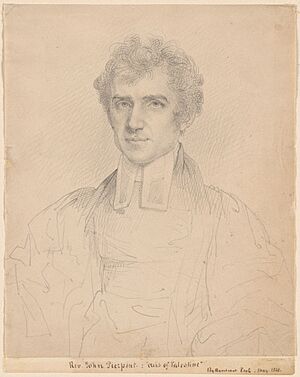Anna Maria Wells facts for kids
Anna Maria Wells (born Foster; 1795–1868) was a poet and writer of children's books in the 1800s. The famous poet and editor Sarah Josepha Hale said that Anna loved reading and music when she was a child. She started writing poems at a very young age. In 1830, Anna Wells published Poems and Juvenile Sketches. This book was a collection of her early writings. After that, she sometimes wrote for different magazines. Sarah Hale thought that Anna's poems were known for their gentle feelings and clear, simple language. Other writers who lived at the same time as Anna Wells included Caroline Howard Gilman, Hannah Flagg Gould, Eliza Leslie, Catharine Maria Sedgwick, and Lydia Huntley Sigourney.
Early Life
Anna Maria Wells was born in Gloucester, Massachusetts in 1795. She was baptized there on September 20, 1795, with the name Anna Mary Foster. Her parents were Captain Benjamin Foster (1769–1795) and Mary "Polly" Ingersoll (1770–1849). Her father, a ship captain, died when Anna was just a baby, between June and September 1795.
Anna's brother, William Vincent Foster (born in 1790), passed away on April 21, 1817, off the coast of Africa. He was the master of a schooner from Boston at the time.
On October 18, 1800, Anna's mother, who was a widow, married Joseph Locke (1767–1838). He was a merchant in Boston. Joseph and Mary Locke lived in Boston and Hingham. They had seven children together. One of their children was the poet Frances Sargent Osgood, who became Anna's half-sister.
Career and Family
Anna Maria Foster and Thomas Wells (1790–1861) got married on August 6, 1821. Their wedding was at the Hollis Street Church in Boston. The ceremony was led by Rev. John Pierpont, who was a poet and minister. Thomas Wells was the son of Captain Thomas Wells. He was also the grandson of the American Revolution hero Samuel Adams. Thomas Wells enjoyed writing poetry. For several years, he worked as an inspector for the U.S. Customs Office in Boston.
In 1825, Thomas Wells read his poem, Ye Shades of Martyred Heroes, to a large crowd. This was during the 50th anniversary of the Battle of Bunker Hill. In 1826, a newspaper called the Boston News-letter praised his writing. It said that both Mr. Thomas Wells and his wife, Anna, were wonderful writers.
Between 1822 and 1828, Anna Wells had four children. Their first child was Thomas Foster Wells (1822–1903). He became a shipping merchant. Their third son, William Vincent Wells (1826–1876), wrote a three-volume biography about his ancestor, Samuel Adams. This book was first published in 1865.
In 1830, Anna Wells published Poems and Juvenile Sketches. This is the book she is most famous for. The Atlantic Monthly Magazine praised it. They wrote that Anna Maria Wells wrote "the purest and best poetry for children." They also said her book was delightful and sold quickly.
In 1834, Thomas Wells joined the Navy as a schoolmaster. He served on ships like the frigate USS Potomac and later the frigate USS John Adams. From 1836 to 1838, he worked as a private secretary. During this time, he wrote Letters on Palestine, about his trips to the Holy Land.
Sarah Josepha Hale wrote about Anna Maria Wells in 1837. She mentioned that Thomas Wells had writing talent but found it hard to settle into a regular job. This meant that Anna had to take on more responsibility for their children's support and education. Anna found that her talent for music was very helpful for this purpose. The historian Sidney Perley suggested that Anna earned her living as an educator. He wrote in 1889 that "Mrs. Wells' chief attention was given to her school for young ladies." She lived in South Carolina for some time during this period.
Anna and Thomas Wells reunited in the late 1830s. They had two more children who sadly did not live long: Joseph Locke Wells (1840–1840) and Mary Ingersoll Wells (1843–1845). In 1842, the New York Herald announced a new newspaper. It was to be edited by Thomas Wells and assisted by his talented wife, Anna Maria Wells. The newspaper venture did not seem to last.
By 1850, Anna Wells was living in New York City with her daughter, Anna Wells Whelpley (1828–1860). Her daughter was married to Dr. James Davenport Whelpley, a physician and editor. Later, Anna Maria Wells lived in Boston with her son Thomas Foster Wells.
Thomas Wells passed away in Boston on December 11, 1861. Anna Maria Wells died at her home in Roxbury Highlands, Massachusetts, on December 19, 1868. Even though they lived apart for many years, they are buried together. Their grave is in Forest Hills Cemetery in Jamaica Plain, Massachusetts.
See Also
- Joseph Morrill Wells, architect, Thomas and Anna Maria Wells's grandson
- Webster Wells, mathematician, Thomas and Anna Maria Wells's grandson
- Annie Renouf-Whelpley, artist and composer, Anna Maria Wells’s granddaughter
- Frances Sargent Osgood, poet, Anna Maria Wells's sister
- John Witt Randall, art collector and poet, Thomas Wells's nephew


